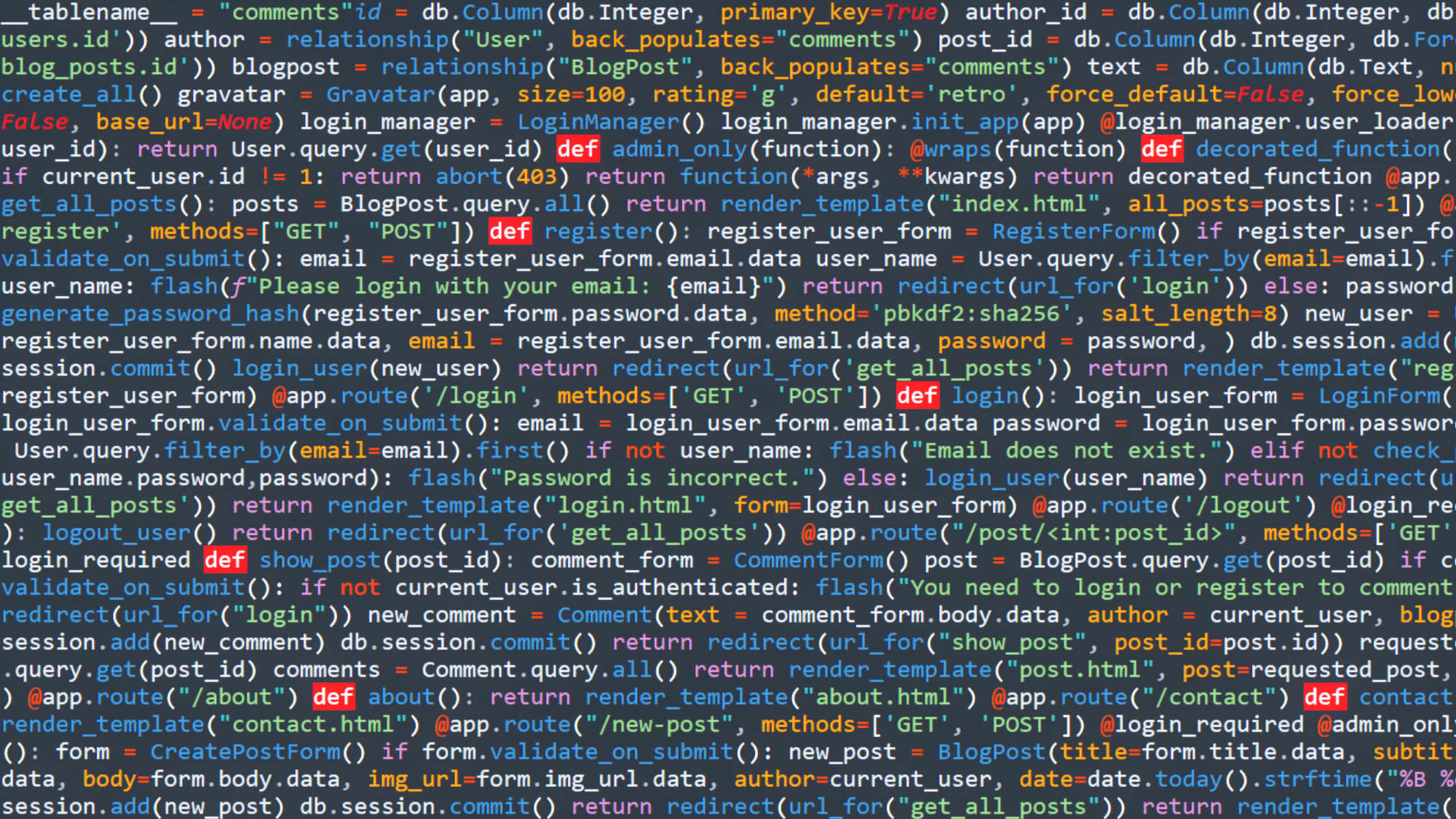Where to Learn Python for Free Online
Writer
Editor
Reviewer
Writer
Editor
Reviewer
BestColleges.com is an advertising-supported site. Featured or trusted partner programs and all school search, finder, or match results are for schools that compensate us. This compensation does not influence our school rankings, resource guides, or other editorially-independent information published on this site.
Find the program that's right for you
Learn new skills quickly with a bootcamp, or earn a degree from a traditional college.
Answer a few questions to get matched with a bootcamp that fits your needs.
Explore accredited colleges to get matched with the best program for you.
- Python is a programming language created by Guido van Rossum in 1991.
- Industries from data science to web development use Python for coding-related tasks.
- Python is easy to learn because it resembles the English language.
- Students can learn Python free online with courses or intensive coding bootcamps.
Guido van Rossum developed Python for a little over a year before posting the first version to USENET in February 1991. Funnily enough, he named the programming language after Monty Python's Flying Circus, a famous British sketch comedy series.
Python is an easy-to-understand programming language capable of many feats. It can develop web applications, create video games, and operate computers. Python's versatility makes it one of the most popular programming languages.
Python skills are still in demand. Anyone can learn Python free online with courses and intensive Python coding bootcamps.
What Does Python Do?
Python is a high-level, general-purpose programming language. It allows professionals to conduct complex calculations, extract and manipulate data, and build machine learning algorithms. Analysts can use it to create data visualizations, such as graphs, pie charts, and histograms.
Developers use Python to communicate with databases and URL routing using frameworks such as Django. Python can send, retrieve, and process data in the back-end (server-side) of website or application development.
It's also a top cybersecurity programming language for accessing servers, analyzing malware, and scanning networks and ports.
Related Programming Bootcamps for You
Top 10 Free Python Courses
1. Google's Python Class
Students with some programming language experience can learn Python free with Google's intensive two-day course. While there are no official prerequisites, students need a basic understanding of programming language concepts, such as if statements.
Learners initially explore strings and lists using lecture videos and written materials. A coding exercise follows each section, and the exercises become increasingly complex.
This Python course gives students hands-on practice with complete programs, working with text files, processes, and HTTP connections.
2. Microsoft's Introduction to Python Course
Students can learn Python online and build a simple input/output program with Microsoft's introductory Python course. There are no prerequisites for this short, eight-unit, 16-minute class, other than an Azure account.
This online Python course is part of Microsoft's Python learning paths. It prepares students with the concepts and basic skills to pursue more advanced learning.
Students explore Python code, where to run Python apps, learn how to declare variables, and use the Python interpreter. They also learn how to access free resources.
3. Introduction to Python Programming by Udemy
Udemy's introductory Python course doesn't require any previous programming experience. Students only need access to a computer or laptop to get started.
This quick and straightforward course features three sections, 18 lectures, and over an hour and a half of on-demand video lectures. Students receive step-by-step lessons to guide them through Python coding and syntax, beginning with the basics.
Learners explore strings, variables, and data types, then move on to loops and conditions, file manipulation, and functions.
4. Learn Python - Full Course for Beginners by freeCodeCamp
This free YouTube tutorial developed by Mike Dane is nearly four and a half hours long. It covers the basics to get started programming in Python, including how to install Python.
The freeCodeCamp Python course covers writing code in a text editor versus an integrated development environment (IDE) like PyCharm. Learners explore variables and data types, working with strings and numbers, if statements, and comparisons.
Additionally, students learn how to build a basic calculator, translator, and multiple-choice quiz.
5. Learn Python 3 From Scratch by Educative
This beginner's-level course features a hands-on learning experience in live coding environments using a browser. It takes an estimated 10 hours to complete.
Students learn Python 3, beginning with the basic building blocks and moving to higher-level concepts such as functions and loops. Written lessons, quizzes, and assessments allow students to practice and test their skills.
Interactive coding challenges and playgrounds help reinforce the course concepts and build skills to create basic applications in Python 3.
6. Python for Everybody by Coursera
Programming for Everybody is the first of five Python for Everybody Specialization courses. There are no prerequisites other than basic computer skills.
The first course covers the first five chapters of the textbook "Python for Everybody" and takes approximately 19 hours to complete. Beginners learn how to install Python and the basics of Python 3.
Students learn to use variables to calculate, retrieve, and store information, and programming tools, including functions and loops, to write their first program.
7. Learn Python 2 by Codecademy
Codecademy's introductory course in Python 2 has no prerequisites and takes 25 hours to complete. Students learn fundamental programming concepts and coding using the Python programming language.
Lessons include Python syntax, strings, console output, conditionals and control flow, functions, lists, and dictionaries. Each section consists of lessons and quizzes so students can practice new skills while they learn Python free of charge.
Students will complete projects along the way, including a tip calculator, a command line calendar, and a real-world application.
8. Python for Data Science, AI & Development by Coursera
Python for data science is an online Python and introductory programming course that takes approximately 26 hours to complete. Learners can apply it to multiple specializations.
Using hands-on exercises, students learn Python fundamentals, including data structures, types, expressions, and variables. Additionally, learners will collect data via APIs and web scraping and process it using Numpy and Pandas libraries.
Students will learn to work with data, create basic programs, and solve real-world problems using Python.
9. Learn Python for Total Beginners by Udemy
This beginner online Python course covers the fundamentals of Python 3.6 and Anaconda 5.0.0 using Jupyter Notebook. It takes around seven hours to complete.
Students learn to install the Jupyter Notebook IDE, gaining hands-on experience with its core features and functions. They explore Python basics, data structures, control flow, loops, comprehension, functions, and handling errors.
The course contains seven sections, 32 lectures, and seven exercises, including complete solutions in lecture and PDF formats.
10. Try Django 1.11 // Python Web Development by Udemy
This Udemy course features a little over eight hours of on-demand video focusing on Python web development using Django. Udemy recommends the 30 Days of Python Course as a prerequisite to ensure students understand the Python language.
Students learn the fundamentals of Django, a framework to build web applications with Python 3. They explore topics including database Integration, creating user profiles, and building an internal search engine.
Students build a web app with Django throughout six sections featuring 47 lectures.
Alternative Places to Learn Python
Intensive coding bootcamps are another alternative to learning Python online. Bootcamps are short, comprehensive courses that provide hands-on experiences to learn to code.
Bootcamps often cover computer science basics and languages, including CSS, HTML, JavaScript, SQL, and Python. The best coding bootcamps offer interview preparation and collaborate with industry partners to provide graduates with job placement opportunities.
Typically, students need some programming language experience to enroll in a coding bootcamp. Many require students to take an entrance exam or offer an intro course before enrolling in the more intensive courses.
Python Career Outlook
A Python developer typically works on the server side of project development, using the programming language to code, design, deploy, and debug.
According to limited September 2023 Payscale data, Python developers earned an average annual salary of $81,098. The highest-paid professionals earned $116,000 per year during the same period.
Software engineers typically have experience programming and coding in Python and languages such as C#, Java, JavaScript, and SQL. They work in all stages of the software development process.
Payscale's data shows an average annual salary of $92,378, with the top 10% of software engineers averaging $135,000 annually (October 2023).
Data scientists design and develop processes for modeling data, create algorithms and predictive models, and perform custom analyses. Professionals with skills in Python, machine learning and statistics can earn the highest salaries.
Payscale shows an average annual salary of $99,586 for data scientists, with the highest-paid earners averaging $136,000 (September 2023).
Machine learning engineers research, design, and build the artificial intelligence responsible for machine learning using programming languages like Python. They also maintain and improve existing artificial intelligence systems.
Payscale's data shows an average annual salary of $115,498 for machine learning engineers, with the top 10% of machine learning engineers averaging $157,000 annually (October 2023).
Python vs. Other Programming Languages
Python is one of several popular programming languages. Each has unique qualities, such as:
Python
Python is an interactive, object-oriented programming language suitable for beginner-level programmers. It supports various applications, from web development to machine learning.
Java
Java is a dynamic, portable, object-oriented, and secure programming language. It supports multiple web application threads, multimedia, and dynamic compilation and provides automatic memory management.
C++
C++ is a popular programming language providing a rich library function set that makes development faster. C++ is a valuable tool with uses in databases, web applications, operating systems, game programming, and software engineering.
SQL
Structured Query Language (SQL) allows users to retrieve data from relational database management systems and helps them describe structured data.
SQL can modify database tables and views and create, delete, insert, and update database records.
JavaScript
JavaScript is an open, cross-platform, interpreted scripting language for creating network-centric applications. JavaScript allows developers to add dynamic elements to static HTML pages, automatically update content, and control multimedia.
Frequently Asked Questions About Learning Python
Is Python harder than Java?
Python is easier to understand and write than Java, especially for those with no programming language experience. Its syntax resembles the English language, and Python is an object-oriented programming language, making coding easier.
Java uses more complex syntax requiring more lines of code. Two lines of Python code can often express the same thing as multiple lines of Java code.
How many hours will it take to learn Python?
It can take up to 21 hours to learn Python basics by taking online Python courses. However, how long it takes to learn Python depends on how much experience you have with programming languages.
Python coding bootcamps offer more intensive learning and hands-on skill building. Bootcamps can take anywhere from 2-28 weeks to complete.
Which pays more, Java or Python?
According to data from Payscale, Python and Java offer comparable annual salaries. Python developers earned an annual wage of $79,400 (November 2022), while Java developers earned slightly more at $80,740 (November 2022).
Employers often look for professionals with skills in several programming languages and frameworks depending on the industry and job.
Explore More Bootcamps Resources
View all
What Is a Coding Bootcamp Like?

Best Python Bootcamps






